In Nov. and Dec. of 1816, I saw hundreds of these plants sending out broad, thin ice crystals about and inch in breadth from near the roots. These were melted away by day, and renewed every morning for more than 20 days in succession.Pluchea species [Asteraceae / Sunflower Family] have played a major role in treatments of crystallofolia, although none seem to have been noticed since the 19th Century until my own observations of P. odorata in Central Texas. Ice formations were first recorded for Pluchea foetida (earlier Conyza bifrons / P. bifrons) in 1824 by Stephen Elliot [Sketch of the Botany of South Carolina and Georgia]. Most noteworthy is Elliot's preliminary attempt to explain the phenomenon, seeking possible answers in the plant's anatomy. Botanists of the period seem to have been unaware of his query.
[p. 206]
*The first edition of Eaton's Manual, 1817, was "was issued 'in a contracted form' "[Historica Botanica], and was not likely to have included his comments on Helianthemum, but the common name 'frost–plant' might well have appeared there.
In late November 1828 the Central Texas frostweed, Verbesina virginica [Asteraceae / Sunflower Family], was first observed by Jean Luis Berlandier in the hills above the Guadalupe River (northwest of San Antonio), and described in his journal (first published in 1850 in Spanish: Diario de viage de la Comision de limites ..., with Rafael Chovell; in English from Berlandier's French version only in 1980).* An excerpt from November 28 is given below; for the entire entry for November 28.

In 1833 detailed observations, supported by superb drawings, of a similar frost emergence were reported in England by Sir John Herschel for thistle (Carduus sp. [Asteraceae / Sunflower Family]) and heliotrope (Heliotropium sp. [Boraginaceae / Forget-me-not Family]).*
*London and Edinburgh Philosophical Magazine, 3d series, vol. 2, pp. 110–111 & Plate II, “Notice of a remarkable Deposition of Ice round the decaying Stems of Vegetables during Frost”.

"Fig. (A), Plate II. shows the general appearance of this accumulation;" |
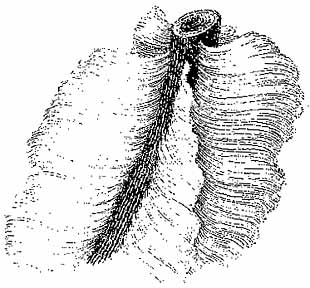
"the mode in which it was attached to the stem, and seemed to emanate in a kind of riband– or frill–shaped wavy excrescence, — as if protruded in a soft state from the interior of the stem, from longitudinal fissures in its sides, — is exhibited at fig. (B)." |
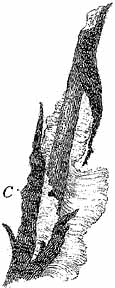
"... the stem presented the singular appearance (C) of a thick massive coating of ice interposed between the wood and its integument, which was swollen and rifted." |
|---|---|---|
- It was chiefly or entirely confined to the immediate neighborhood of the root, the upper parts of the taller unbroken stalks being quite free from it.
- The structure of the ribands is fibrous ....
- ... the direction of the fibres being at right angles to the stem ....
- ... the majority of the stems were sound and solid, and many of them still green when cut.
- The point of the attachment of the ice was, however, always on the surface of the wood, beneath the outer bark or epidermis, which the frozen sheets had in every instance stripped off, and forced out to a distance.
- ... the only quarter to which we can look for their origin is in the plant itself, or in the comparatively warm earth beneath, to whose exhalations the decaying stems may form a kind of chimney.
- What share the physiological functions of the plant may have in the phænomenon, or whether it be connected with the vitality of the stem at all, is for botanists to decide.
Four years later, 1837, William Darlington's Flora cestrica added Cunila origanoides (earlier Cunila mariana) 'common dittany' [Lamiaceae / Mint Family] to the list of known frost plants [p. 350]:
In the beginning of winter, after a rain, very curious and fantastic ribbands [sic] of ice may often be observed, attached to the base of stems of this plant — produced, I presume, by the moisture from the earth rising in the dead stems by capillary attraction, and then being gradually forced out horizontally, through a slit, by the process of freezing. The same phenomenon has been noticed in other plants. See obs. on Helianthemum, p. 314.Darlington's reference to Dr.Jacob Bigelow in part reflects H. canadense's long standing use as an herbal medicine (as Cistus). Constantine Hering et al (1866) write:Prof. Eaton and Dr. Bigelow have noticed the formation, in freezing weather, of curiously curved ice–chrystals near the root of H. canadense. I have not observed them in that plant; but have seen them very beautiful in the Cunila mariana or Dittany. Mr. Elliot, also, remarked the same phenomenon in the Conyza bifrons. Vide Ell. Sk. 2. p. 322.
It is an old popular medicine in this country for all kinds of so-called scrofulous diseases and had after being introduced in Great Britain in 1799, gained such a reputation that it was cultivated from seeds.But they also note being unable to find reference to Cistus in Bigelow's publications.
In 1843 John Torrey's A flora of the state of New York : comprising full descriptions of all the indigenous and naturalized plants hitherto discovered in the state; with remarks on their economical and medicinal properties, vol. 1, p 77, gives common names for H. canadense as 'Frost–weed, Frost–wort,' with the comment:
It received its popular name from the circumstance of its shooting out, early in winter, icy crystals from the cracked bark near the root. A similar phenomenon has been noticed in several other plants but has not yet been satisfactorily accounted for.* [Torrey's note refers to Herschel's article. It is interesting that he seems unaware of Elliot and Darlington.]
Asa Gray's A manual of the botany of the northern United States (first edition, 1848) seems to follow Torrey in noting for H. canadense ('frost–weed'):
Late in autumn crystals of ice shoot from the cracked bark at the root, whence the popular name.But he does not mention this with the second Helianthemum species listed, H. corymbosum, nor does he note it in his description of Cunila mariana (dittany, now C. origanoides) or Pluchea foetida. And later 19th Century editions do not change this. The 1908 7th edition, New Manual of Botany, revised by B. L. Robinson and M. L. Fernald, extends the frost description to a newly recognized third Helianthemum species, H. majus (now H. bicknellii), added by Fernald (author for the species). Why Gray seemed to limit his recognition of the phenomenon may at first blush seem strange, but it seems inconceivable that it was because he was unaware of the reports by Elliot and Darlington, among the most notable contemporary writers on botany. Since the early common name 'frost–plant' (later 'frost–weed', even 'iceplant' 'frost–wort') was in usage, especially among herbalists, it thus merited comment in a work that otherwise provided a terse minimalist taxonomic listing of known species with only distinctive traits indicated.
The first detailed study came only in 1848, by John Le Conte of the University of Georgia, based on Pluchea foetida and P. camphorata (published in 1850). Le Conte provides illustrations, commenting:
The root is perennial, but the stem is annual and herbaceous. [p. 21; but this seems to conflict with the unqualified statement on p. 33:Le Conte's general descriptions, as well as one drawing (figure C), are at times presented without quotes or attribution virtually unchanged from Herschel; or if in quotes, modifications are not noted. (For a comparison.)the reason why the phenomenon is manifested only in certain kinds of plants, probably arises from several peculiarities in their physical condition. ... They must be herbaceous and annual to secure medullary rays of sufficient size and openness, and, it is probable that all vital action mush have ceased in order that the fluid which is elevated from the soil may be unmixed with the proper juices of the plants; a mixture which would interfere with congelation.The stalks thus became completely rifted by a succession of severe nights, from the height of six or seven inches down to ground. [p. 23]
The stems which had been cut off within three or four inches of the ground, exhibited the phenomenon as conspicuously as those which were left untouched. [p. 24]
They [ice formations] frequently commence two or three inches from the ground, and extend from three to four inches along the axis of the stem. (Fig. A.) It is proper to state that, at this season, the stalks are dead, and quite dry to within six inches of the earth, below which they are generally green and succulent.
[For Le Conte's explanation.]
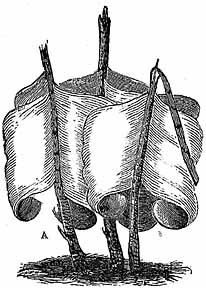
The additional facts which my observations establish ... appear to be irreconcilable with the idea that the physiological functions of the plant have any share in the production of it. We must, therefore, look to the moist earth for the large supply of water necessary for the development of these voluminous masses of ice. [p. 24]
The phenomenon manifested on certain plants is every way analogous to that relating to the protrusion of ice from certain kinds of soil, and admits of the same explanation. The porous pith furnishes a constant supply of warm water from the earth, while the wdge-shapred medullary rays secure the mechanical conditions necessary for the development of a projectile force in the proper direction. [p. 33]
The first of these was by Robert Caspary, 1854, who had observed the same formations on 11 exotic species in a German botanical garden. Unlike the natives in natural environments thus far observed, Caspary's plants had been caught by a hard frost in a fresh green state, "even in bloom," and perished. These included annuals (2) as well as perennials (9). He refers to the formations of the type in Figs. 1 & 3 below as Eisblätter [ice leaves]; those of the type in Fig. 2 as fasrige Eislage [fibrous ice layers] — a distinction he maintains throughout the article, implying an essential difference. [Note: Our Verbesina virginica exhibits both types on the same stem, depending upon the extent of the epidermis rupture, the ice formations being identical in structure but not in scope.]
| Fig. 2. Lantana aculeata [Verbenaceae / Vervain Family] |
Figs. 1 & 3. Cuphea cordata [Lythraceae], Transverse section on right. (Fig. 1 was slightly edited & colorized by Bob) a = stem ('greenish'); b = ice (blue); c = torn loose epidermis (grey). |
||
|---|---|---|---|
| Caspary's 1854 images. | |||
The ice formations occurred not only at the base of the stems of the plants, but everywhere; also the most remote, highest and thinnest twigs, which were elevated roughly 3 feet above the soil ....And he argues [pp. 672-3] that by his measurements the medullary rays [Markstrahlen] cannot account for the dimensions of the observed ice lamellae, additionally claiming that two of the seven species he studied in detail even lacked medullary rays.
The fact that these were all exotics subjected to freezing temperatures at a stage of growth not matched by plants in their native environment leaves open the possibility that Caspary's findings may only indirectly shed light on the biophysical mechanisms of crystallofolia as a natural phenomenon. But his work must stand as one of the most significant contributions to the general process of ice crystal formation in plants.
In 1860 a second German plant physiologist, Julius Sachs, published a lengthy article on ice formation in plants in the broadest possible sense. In general he added relatively little to the previous studies of crystallofolia in the narrow sense, relying primarily on Caspary's survey for earlier work, and quotes only a couple of paragraphs from Caspary. Worth noting among his observations are:
The quantity and manner of formation of the crystals shows in any case that the water in their formation does not arise either through the contraction of the base/substratum [Unterlage] alone nor through the expansion of the water. [p. 16, page refs. to the 1890 reprint of the article]Sachs alone recognizes the significance of freezing phenomena for issues of plant distribution and natural selection.It is clear that the mode of explanation that I have given applies equally well to the soil as to plant tissues. I thus agree completely with v. Mohl's view, when he claims no essential difference between the ice formation in the soil and in plants. [p. 17; this essentially echoes Le Conte's view]
Prof. H. Hoffmann in his Grundzügen der Pflanzenklimatologie 1857 pp. 327–329 has given measurements in order to identify the contraction of succulent plant tissues during freezing using volumetric means. The contractions which he achieves in this way amount to 21 to over 30 percent of the original volume in the leaves. This quite incredibly large contraction prompted me to conduct new experiments on this subject, all the more so since I considered the method used by Herr Hoffmann to be unfeasible. [p. 18; Sachs' new experiments [pp. 18–20] do not support Hoffmann's views on contraction.]
Unfortunately the necessary conditions for the data given here are still too little known; but they merit the greatest attention not only from a physiological point of view, but are also of decided importance for plant geography and evolutionary history, as A. De Condolle repeatedly notes. [p. 41]
Gray 1868 (Gray's lessons in botany and vegetable physiology... glossary, or, dictionary of botanical terms; (also) Manual of the botany of the Northern United States) lists three species of Helianthemum, and gave the genus common name as FROSTWEED, associating ice formation at the genus level.
Two short papers from the last quarter of the century advanced our knowledge of crystallofolia with Cunila origanoides. In the first of these Pennsylvania naturalist Jacob Stauffer noted, 1877, that the root was not dormant:
... I took up a number of the plants, and always found a vigorous scaly root bud, undergoing development at this early season under ground, to produce a new stem the following spring. I came to the conclusion that, as the temperature was below freezing and snow was on the ground, the expanding bud, in close proximity to the surface, gave out sufficient caloric or warmth to generate vapor from the moist soil.The second, by Lester Ward, 1893, who was unaware of previous descriptions of Cunila crystallofolia, provided excellent details of the formations on the quadrangular–stemmed mint — which are quite unlike those in the round–stemmed species — the corners seemingly providing structural support. [But see also Coblentz's 1914 study below.]
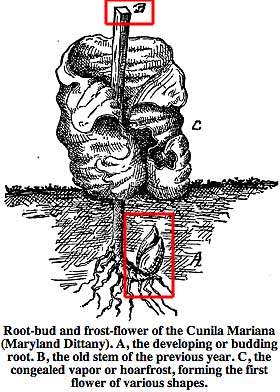
Note the quadrangular stem typical for mints. (Edited by Bob)
There were always several of these, usually three, four, or five, all attached to the same vertical portion of the stem but at regular intervals around it like the paddles of a flutter-wheel, but all curving in the same direction after the manner of a turbine wheel. Thus, where there four they stood with each pair opposite, as in the accompanying cuts....Two very general surveys of the phenomenon appeared in the 1890s. Plant physiologist Daniel T. MacDougal, in a short but detailed two page Science 1893 article, presented a number of claims, some of which would seem to indicate limited knowledge of previous work in this area, Le Conte as well, including:
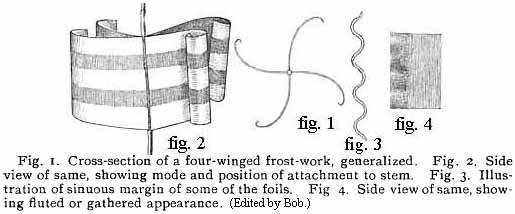
The century closes with a report on the state of ice crystal research (in the broadest sense) by J. Christian Bay, Botanical Gazette, 1894. Bay's listing of "Plants on which ice-crystals have been observed," might seem to be a useful resource, but it goes beyond natural crystallofolia and includes arboreal needle ice as well as freezing of exotic species in cultivation in cold climates, and unverifiable identifications (and dates).* Species are presented in assumed chronological order of published presentation with no indication of crystalization type. (Bay was unaware of Eaton 1818.)
- That the fluid does take this course [via the vessels and medullary rays] in the dead stems was proven by the author, by allowing them to absorb and carry up colored solutions.
- Then root pressure must be wanting as well as osmotic activity in plants at this stage.
[MacDougal seems unaware of earlier articles that seem to indicate the opposite; e.g. Caspary and Stauffer.]- Neither can the elevation of the water be due to "negative pressure," since the portion of the stem above the crystal-forming part may be split, or broken, or cut entirely away, without affecting the formation of the crystals.
- The constant absorption and evaporation by the dessicating tissues limit the region of saturation and confine the formation of crystals to the basal portion of the stems.
[Earlier work by Caspary shows this not to be valid, and my own observations indicate that this limitation is valid only once higher portions of the stem have been dessicated by freezing ruptures.]- ... the only structural conditions necessary are large and numerous vessels, thin-walled medullary cells in a well marked ray, and a bark easily split longitudinally. The category of plants furnishing these conditions is by no means small.
[My own observations indicate that the bark must first withstand a considerable buildup of pressure before rupturing — as do Caspary's drawings.]- And it seems highly probable that frost phenomena may be exhibited by any of these plants which may pass through the death stage at the season affording the necessary conditions of temperature and moisture. [p. 352]
[Does the ornate 'pass through the death stage' mean 'die' — MacDougal explicitly rejects Le Conte's erronious (p.33): "They must be herbaceous and annual ....:"His reasoning that plants to show frost phenomena must be annual and herbaceous is entirely false, since the very plants upon which he worked are described by many botanists as biennials, as well as Helianthemum, on which the phenomenon is most frequently noticed. [p. 351]thus ignoring Le Conte's earlier statement that the roots are perennial. [see above]
But perhaps MacDougal intended 'experience dormancy,' since the process in a natural context only occurs with overwintering perennials, but even so, as Stauffer noted, the roots are not dormant.]
*E.g., "(?) Vernonia> sp. [Asteraceae; Atkinson, 1885–6]." This is from a brief 1894 article in which George F. Atkinson describes his field observations of Cunila in 1885–6. At the end of the article he notes having "discovered also one other plant [we are not told when] which produced these frost freaks ... From the observations I made at the time I can safely say that it was either some species of Eupatorium or Vernonia, more likely the latter. I regret now that I did not acurately determine the species".
New to Bay is the dubius claim that contraction of tissue plays a significant role in the ice formation (based on the work of German Botanists, especially Hermann Hoffmann (Witterung Und Wachsthum Oder Grundzüge Der Pflanzenklimatologie, 1857). Bay presents the following speculation [p. 325; contrast, however, the view of Sachs given above]:
The cold causes a contraction of the tissues all over the plant, and consequently the turgescence is very much diminished, as well as the permeability of the cell-walls to water. As the contents of the peripheral ends of the medullary rays freeze, expand, and are pressed forward, the stem splits in the place where it affords the least resistance, and the ice forms a layer covering the whole surface of the wound. The pressure from inside supplies water, the latter being drawn up by capillary forces.
Perhaps his most significant contribution lies in his detailed analysis of the structure of Cunila stems and the manner in which that quadrangular–stemmed mint projects its frost. The following images, colorized and slightly edited from his originals, show that:
As shown in figures 1 and 12 the stem is somewhat rectangular in outline, the pith having a similar shape, but the "corners" are rotated 45°.* At these "corners" of the pith [outlined in red below] there is but little wood between the pith and the bark, and it is along this line that the stem often cracks. ... in figures 11 and 12. The numerous holes in the wood are the "sap tubes" [in blue in Fig. 12] which form an easy path for the moisture to rise within the stem, by capillary attraction. [p. 492]
*Contrast my own sections of related mint Salvia coccinea for which the pith corners are aligned with those of the stem.
(p. 492) |
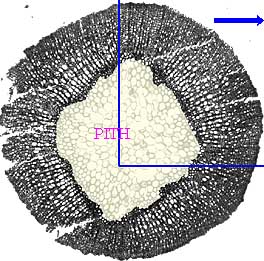
Fig. 12 — Cross section of stem of Cunila mariana (p. 498; much reduced; blue area shown enlarged on the right; the bark and cortex seem to have been stripped) |
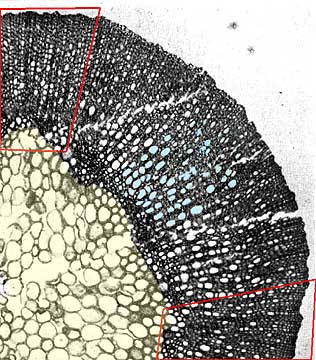
Top right corner of Fig. 12; selected xylem vessels in blue; xylem rays clearly visible in area identified as 'wood' by Coblentz |
|---|
It was found that the ice fringes rarely start from the side of the stem where the pith is closest to the bark. This eliminates, to some extent, the question whether the pith is instrumental in forming the ice fringes. In the splinters and in the rifted stems of Cunila, at no time was ice found to have formed along the line of separation of the stem. This seemed puzzling at first, for it appeared to contradict the idea that the moisture comes from the sap tubes within the stem, in which case one would expect to find the formation of ice fringes facilitated upon the surface laid bare by splitting. ...Coblentz is left to wonder why his artificially generated ice crystals are not fibrous like those in nature.The microsections of the Cunila stems show in a very unexpected manner why no ice fringes are formed upon the rifted surface of the stem. As already stated, the rift always occurs at the "corners" of the pith where the woody part of the stem is the thinnest. It may be noticed in figures 11 and 12 that at the four points where the wood is the thinnest there are usually but few, if any, sap tubes. Hence one need not expect to find ice formations upon the surfaces formed by splitting. [p. 492]
The main difficulty in this explanation of the cause of ice fringes lies in the fact that the second stage in their formation is an apparently solid wedge of ice (see, however, fig. 3B), whereas the mature fringe is fibrous in structure, very friable, and often separates into a series of wide ribbons as thin as tissue paper. The fibrous structure, however, may be the result of reformation by variations in air temperature, by evaporation, etc., which produces the white fringe shown in the photographs. [p. 497]Had Coblentz had a broader and better understanding of the 19th Century scholarship in this area, his arguments and speculations surely would have been different. One issue worth noting in Coblentz are his claims regarding root pressure.
The roots are not necessary for the production of the ice fringes. As a matter of fact the stalk and the near-by roots are dead, although the rest of the plant (new growth) is perennial. [p. 495]No one has claimed (in the published literature) that root pressure alone causes these formations, but he fails, however, to show that root pressure does not play a significant role in naturally occurring ice formations — but note his tests with cut stems below. Whether he considers the roots to be dead or perennial is not clear.They [photographs] show that the ice may be formed upon stems without the roots. Hence the ice is not formed as result of hydrostatic pressure excerted by the roots, which are perennial. [p. 499]
Finally, one interesting experiment with rootless stems is presented (p. 493). Laboratory test A showed that stems that had been drying for nine weeks very rapidly absorbed moisture after being placed in water. The next morning two of four stems were 'thorougly soaked.' Then for test B, the two most active samples of test A were
"thoroughly dried and covered with cement, K [blue], and placed in water containing a red dye. Sample a was covered at the top, K, so that the water would have to come out at the sides. The sides of the immersed part of this stem were covered with cement, so that the water would have to traverse the sap tubes in order to reach the top. the immersed end of sample b was covered with cement, so that the water would have to soak in through the sides in order to traverse the stem. The next morning...(uncolored), moisture was observed on the sides of a, and the top of b showed the red dye."

|

|
|---|---|
| Experiment B. K & dark blue = cement; red = red dye; light blue = uncolored moisture | |
Subsequent similar tests for capillary force with cut stems were made to see how high the water would rise (p. 493):
... the stems were more than 6 cm. in length, and it was found that the water rose to a height of 5 cm. However, when uncovered and exposed to the wind the moisture did not rise higher than 1 cm. to 2 cm.In comparison with known crystallofolia significantly higher on the stem (over 4 feet), Coblentz seems to have demonstrated that capillary forces alone can't account for the data — perhaps the tests also support a significant role for root pressure in naturally occurring formations.